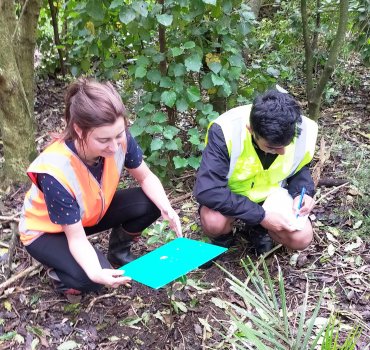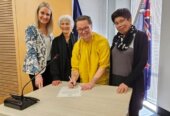
Wintec science students, Dip Barot and Sasha Dowling measure the extent to bird poo – guano – at Rotopiko.

Wintec science students, Dip Barot and Sasha Dowling measure the extent to bird poo – guano – at Rotopiko.
Eradication of pests at a Waipā lake has been so successful a new problem has arisen – in the form of pest birds.
Hundreds of thousands of starlings and sparrows roost in the pest fenced reserve around Rotopiko – and their nutrient rich poo is jeopardising the entire restoration project.
Starlings are listed among the world’s biggest pests.
Wintec science tutor and academic Nicolas Sandoval said the National Wetland Trust, which is leading the Rotopiko project, had expressed concern about the concentrations of nutrients resulting from the large amount of guano – bird poo – being dropped each night. The Trust sought help from Wintec to measure the scale of the problem and come up with some solutions.
Now a science research team from Wintec is working to help save Rotopiko – Lake Serpentine – in what is being as a first study of its type.
“The side effects of mammalian control have been overlooked in New Zealand and we are the first researchers to look into this,” Sandoval said.
They are part of a collaborative research project launched in 2020 between the National Wetland Trust, Wintec and Toi Ohomai Institute of Technology.
Sandoval who is overseeing the Wintec research says an issue with developing native sanctuaries like Rotopiko is that exotic birds use their defensive mechanisms, such as identifying predators, to know that inside the pest proof fence the habitat is free of predators and safe for them to roost.
Since the completion of its pest-proof fence in 2013, and the successful eradication of unwanted mammals – except for a few mice – the lake has become a sanctuary for ‘pest’ birds which have now reached plague proportions.
The Waikato hosts the largest collection of peat lake habitats in New Zealand and Rotopiko, south of Ōhaupō provides a habitat for animals and plants adapted to these special wetland characteristics.
“An estimated 500,000 birds arrive each night to roost at Rotopiko,” Sandoval said. “They sleep together in groups shoulder to shoulder. The sound is deafening from this collective of birds squawking until sunrise where they then disperse until sunset.”
The research team recorded the resident birds during the day and again in the evening roosting time when their deafening sound becomes a clamour not unlike a thousand tambourines being played at one time. Sandoval says the contrast between the two demonstrates the scale of the roosting problem.
Wintec science students, Dip Barot and Sasha Dowling have been carrying out multiple research activities since Wintec’s first involvement last June that aim to control the growing population of pest birds at the site.
The students started by creating a monitoring index, placing 50 plates across the wetland to measure the amount of guano. They collected the results twice a day to determine how many roosting (night) and resident (day) birds are at the lake. Sound recorders were also used to give a different type of measure, and they compare their results to the plates to generate a robust monitoring system.
“Creating the guano plates was interesting because, as far as we know, this method has not been used to measure a bird population of this size,” Dowling says.
With a monitoring system in place, this year the Wintec science research team will collect chemical and biological data to compare with the index.
Sandoval says the high level of guano in winter is a potential health issue.
“The lake was originally intended is being developed as an educational hub/wetland centre for primary schools to do activities and learn about wetlands and conservation.
“If this pest bird problem continues to grow, it will severely threaten the health of the ecosystem and the enjoyment by visitors.








